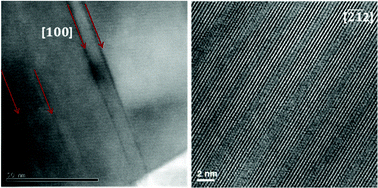Partial sodiation induced laminate structure and high cycling stability of black phosphorous for sodium-ion batteries†
Abstract
Black phosphorus (BP) is a promising anode material for sodium ion batteries (SIBs) due to its extremely high theoretical capacity. However, the large volume change and breaking of the layered structure result in rapid capacity decay during cycling. Herein, our in situ transmission electron microscopy (TEM) study reveals the highly anisotropic Na diffusion and the formation of alternating layered and amorphous lamellas in BP nanosheets with small volume expansion induced by partial sodiation. Inspired by these results, we investigate systematically the cyclability of BP at controlled discharge capacities using half-cell SIBs, expecting to achieve good cyclability by sacrificing some of the capacity and preserving the layered structure of BP. Our results show that the cycling stability of BP is obviously improved by controlling the capacity appropriately. When the discharge capacity is limited at 400 mA h g−1, the half-cell can sustain more than 100 cycles with an active material mass loading of ∼2 mg cm−2, which is at least 4 times longer than when the capacity is limited at 600 mA h g−1 or above. The in situ TEM and electrochemical tests indicate that maintaining the layered structure by controlling the capacity is key to improve the cyclability of BP as an anode in SIBs.



 Please wait while we load your content...
Please wait while we load your content...